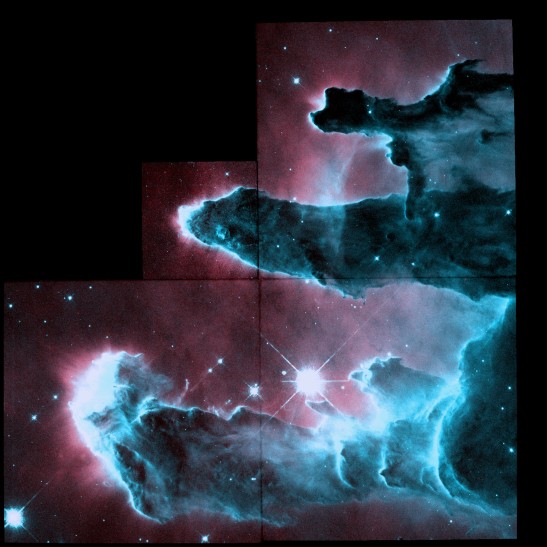
One might look at the above photo and ask, “Ben, how in the world did you create such a beautiful tri-color photograph of the deep sky Eagle Nebula? You are an extremely talented individual, and, as such, I would like to offer you gifts and money.” Now, while I do appreciate the well deserved encouragement, the process is not all that difficult. In fact, most of the straight-forward instruction is written into the description of the photo: a “tri-color image”. A photo like the one posted above can be easily recreated using three separate photos of the same image, each one using a different wavelength filter in order to express as wide a range on the visible spectrum as possible.
Ideally, one would have three different photos: one photo expressing a wavelength at the low end of the visible spectrum, a second photo expressing a middle wavelength, and finally a third photo expressing a wavelength approaching the high end of the visible spectrum. Once all three photos are collected they must simply be layered on top of one another (using a program like Adobe Photoshop), with the mid-wavelength photo on top of the lowest wavelength, and the highest wavelength photo on the very top above the previous two. One may then choose to manually alter the image, layer by layer, in order to achieve desired color, contrast, etc. An alternative, much faster option, is to simply utilize a downloadable Adobe “action” in order to maximize each individual photo’s expression of the desired wavelength of the visible spectrum, rather than having to fruitlessly explore Photoshop’s many tools until one somehow arrives at his or her desired image. Once the colors of each photo have been customized, one must simply crop to their desired image size, and Huzzah!, the image is complete.
Below I have posted all the links one will need in order to replicate the “Eagle Nebula” above:
A compilation of downloadable deep space imagery
The application needed in order to open said images
The Photoshop “action” is available here
Detailed instructions for the entire process
All links courtesy of spacetelescope.org. Adobe Photoshop is, unfortunately, not included.
And now some quick info on this “Eagle Nebula”:
Although EagNeb, as i have affectionately renamed it, was discovered was as early as the mid-eighteenth century, it was not available as a defined image until 1995, when the Hubble Space Telescope finally caught sight of this incredible, interstellar, cloud of gas and dust about seven-thousand lightyears from Earth, and, taking advantage of the situation at hand, snapped a candid-photo. Alternatively called M16, the nebula has been estimated to age only 5.5 million years, a proportionally minuscule life in comparison to our own Milky Way. It is also much smaller than our own galaxy, measuring approximately seventy by fifty-five lightyears in area. The nebula is thought to be filled with star-forming pockets of dust and gas, especially in nebula’s best known, not to mention pictured above, component, the “Pillars of Creation.” These “pillars” stretch for lightyears into space, suggesting that the galaxy might be able to give birth to an exponential number of stars. However, while EagNeb is filled with the materials required for star formation, lack of x-ray activity points to the hypothesis that these pillars are close to burning their star-forming wicks all the way to the ground. Last little tidbit, researchers in 2007 compiled evidence leading to a second hypothesis: a stellar supernova occurring close to six-thousand years ago may have already blown these pillars out of position; We will not be able to test this hypothesis for another thousand years, however, as the light will not have reached us until then.
Works Consulted:












